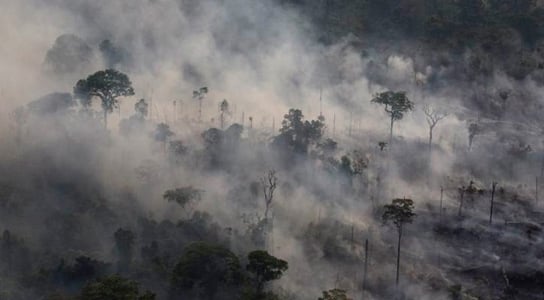
The western Amazon faces unprecedented threats from a warming climate and human population growth. Existing protected areas may not suffice to mitigate the forthcoming challenges.
In the past few years, the Amazon rainforest in Peru’s Ucayali region has been hit by two severe droughts, one in 2005 and another in 2010. These dry spells could become more frequent as temperatures in the tropical North Atlantic Ocean continue to rise and as thousands of square kilometers of forest are burnt to make way for farming.
The scientists presented their findings on December 7 at the American Geophysical Union meeting. This region has seen warmer temperatures in the past, but the western Amazon is under siege now from a combination of a warming climate and human population growth, something it has never faced before. The current protected areas might not be enough to buffer against the upcoming changes.
Migration from the Andean highlands has boosted Peru’s Amazonian states to the top of the population growth charts, and the heavy influx of people has started to take its toll on the forest. The country has lost about 6,475 square kilometers (2,500 square miles) of forest, which is an area the size of Delaware, between 2005 and 2009. This number is up from a loss of 4,550 square kilometers (1,760 square miles) in the five previous years. This loss translated into reduced precipitation, further stressing the remaining trees. About 50% of the rainfall of the Amazon is generated by the forest itself, through transpiration and evaporation. Deforestation exacerbates the drought problem, removing an internal engine that boosts precipitation.
Clearing fields and pastures leaves more exposed forest edges, drying out the interior and making it more likely to burn if agricultural fires escape. During 2005 and 2010, fires added 3.8 gigatons of carbon into the atmosphere. Recent studies have found that Amazonian trees have weathered past climatic warming, but the changes were slower and not exacerbated anthropogenically.
Trees can acclimate, species can either adapt, migrate, or simply go extinct, states Kenneth Feeley, a biologist at the Florida International University. A floral species could expand its range into a cooler region, but only as fast as seed dispersal allows. There have already been changes in the eastern slope of the Peruvian Andes. Species are moving upslope at about 3 vertical meters a year, which is fast but this might not be fast enough. They need to move between 9 or 10 vertical meters a year.
Deforestation in the lowlands reduces the areas to which species can spread. Fields, pastures, and road create barriers to dispersal. Peru has large protected areas, but scientists aren’t sure whether these are big enough or in the right places, to allow species to migrate in a rapidly changing climate.
Rainfall, geology, and topography in the western Amazon have given rise to a mosaic of ecosystems that are so diverse that they are virtually unknown, states Asner, a tropical ecologist at the Carnegie Institution for Science at Stanford University. Scientists have little data on which to base their conservation plans.









Be the first to comment on "The Amazon Rainforest Could Be Drying Out"